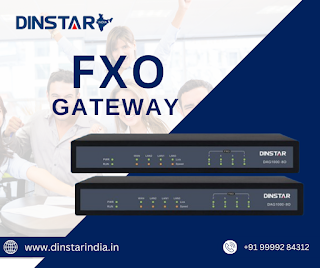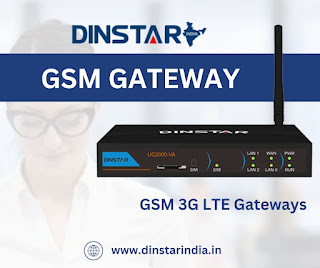Understanding FXO and FXS Gateways: Bridging Traditional and Modern Telecommunication
The ever-evolving world of telecommunications, businesses often need to integrate traditional phone systems with modern VoIP (Voice over Internet Protocol) technology. This integration ensures continuity, cost-efficiency, and enhanced communication capabilities. Two crucial devices facilitating this integration are the FXO (Foreign Exchange Office) and FXS (Foreign Exchange Station) gateways. In this blog, we will delve into the functionalities, differences, and applications of FXO and FXS gateways to provide a comprehensive understanding for businesses and tech enthusiasts alike.
What is an FXO Gateway?
An FXO gateway is a device that connects a VoIP network to the PSTN (Public Switched Telephone Network). The term FXO stands for Foreign Exchange Office. Essentially, an FXO gateway acts as a bridge, allowing VoIP systems to interface with traditional analog phone lines.
Key Features of FXO Gateways:
Analog to Digital Conversion: FXO gateways convert analog signals from the PSTN into digital signals for VoIP systems.
Call Routing: They enable call routing between VoIP and PSTN, allowing users to make and receive calls seamlessly.
What is an FXS Gateway?
An FXS gateway, on the other hand, connects VoIP networks to traditional analog devices like phones and fax machines. FXS stands for Foreign Exchange Station. This gateway provides the dial tone, power, and ring signal to analog devices, enabling them to communicate over a VoIP network.
Key Features of FXS Gateways:
Digital to Analog Conversion: FXS gateways convert digital signals from VoIP systems into analog signals for traditional devices.
Power Supply: They provide power to analog devices, allowing them to function correctly.
Ring Signal Generation: FXS gateways generate the ring signal, enabling analog phones to ring on incoming calls.
FXO vs. FXS Gateways: Key Differences
Understanding the differences between FXO and FXS gateways is crucial for selecting the right device for your needs.
Functionality:
FXO Gateway: Connects VoIP systems to the PSTN.
FXS Gateway: Connects VoIP systems to analog devices.
Signal Conversion:
FXO Gateway: Converts analog PSTN signals to digital VoIP signals.
FXS Gateway: Converts digital VoIP signals to analog signals for traditional devices.
Power Supply:
FXO Gateway: Does not supply power; it relies on the PSTN for power.
FXS Gateway: Supplies power to analog devices.
Use Case:
FXO Gateway: Ideal for businesses transitioning from PSTN to VoIP, ensuring that existing analog lines can still be utilized.
FXS Gateway: Suitable for integrating traditional analog devices into a VoIP network.
Applications of FXO and FXS Gateways
FXO Gateway Applications:
Business Continuity: Ensures that businesses can continue using their existing PSTN lines while transitioning to VoIP.
Cost Savings: Reduces costs by enabling VoIP calls, which are generally cheaper than traditional phone calls.
Remote Offices: Connects remote offices with the main office’s VoIP system, enhancing communication and reducing long-distance call charges.
Backup Lines: Serves as a backup in case of VoIP service disruptions, maintaining uninterrupted communication.
FXS Gateway Applications:
Analog Device Integration: Allows businesses to keep using their existing analog phones and fax machines with a modern VoIP system.
Residential VoIP: Enables residential users to connect their home analog phones to a VoIP service.
Enhanced Features: Provides additional features like call forwarding and voicemail to analog devices, improving overall communication efficiency.
Choosing the Right Gateway for Your Needs
Selecting the right gateway depends on your specific requirements and existing infrastructure. Here are some tips to help you make an informed decision:
Assess Your Current System: Determine whether you need to connect to PSTN lines (FXO) or integrate analog devices (FXS).
Evaluate Compatibility: Ensure the gateway is compatible with your existing PBX or VoIP system.
Consider Future Expansion: Choose a gateway that can accommodate future growth and additional features.
Budget Constraints: Consider the cost of the gateway and potential savings from reduced call charges and maintenance.
Setting Up FXO and FXS Gateways
Setting Up an FXO Gateway:
Connect to PSTN: Connect the FXO ports to your PSTN lines.
Connect to VoIP System: Use Ethernet cables to connect the FXO gateway to your VoIP system or IP PBX.
Configure Settings: Access the gateway’s web interface to configure settings such as SIP server information, call routing rules, and caller ID preferences.
Test the Connection: Make test calls to ensure the gateway is functioning correctly and calls are routed properly between the PSTN and VoIP system.
Common Challenges and Troubleshooting Tips
FXO Gateway Issues:
Poor Call Quality: Ensure that all connections are secure and check for any network issues. Consider adjusting the codec settings.
Call Routing Problems: Verify the call routing rules in the gateway’s configuration and ensure they match your desired setup.
Caller ID Issues: Make sure caller ID support is enabled in both the gateway and your VoIP system.
FXS Gateway Issues:
No Dial Tone: Check the power supply to the analog devices and ensure the FXS ports are correctly connected.
Conclusion
FXO and FXS gateways are crucial in bridging the gap between traditional telecommunication systems and modern VoIP technology. Businesses can make informed decisions to enhance their communication infrastructure by understanding their functionalities, differences, and applications. Whether you're integrating existing analog devices into a VoIP network or connecting to the PSTN, these gateways provide the necessary flexibility and efficiency for a seamless transition. As technology continues to evolve, staying informed about these essential tools will ensure that your communication systems remain robust, cost-effective, and future-proof.



Comments
Post a Comment